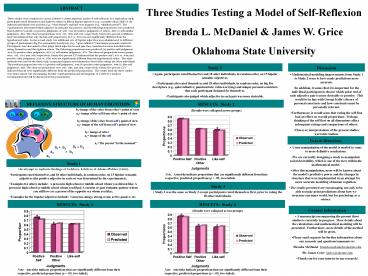Three Studies Testing a Model of Self-Reflexion
1 / 1
Title:
Three Studies Testing a Model of Self-Reflexion
Description:
ABSTRACT Three Studies Testing a Model of Self-Reflexion Brenda L. McDaniel & James W. Grice Oklahoma State University Three studies were conducted to assess Lefebvre ... –
Number of Views:61
Avg rating:3.0/5.0
Title: Three Studies Testing a Model of Self-Reflexion
1
ABSTRACT
Three Studies Testing a Model of
Self-Reflexion Brenda L. McDaniel James W.
Grice Oklahoma State University
Three studies were conducted to assess Lefebvres
(1998) algebraic model of self-reflexion. In a
replication study, participants rated themselves
and eighteen others on fifteen bipolar adjectives
(e.g., excitable-calm). Half of the eighteen
individuals were positive (e.g., close friend)
and half were negative (e.g., disliked person).
The experimenters determined which adjective in
each pair was positive, and the following
proportions were predicted from Lefebvres model
(a) positive judgments of self, .719 (b)
positive judgments of others, .628 (c)
self-similar judgments, .619. The observed
proportions were .757, .606, and .615,
respectively. Ninety-five percent confidence
intervals indicated that only the like-self
proportion (.615 vs. .619) was not significantly
different from the hypothesized value. In the
second study, two additional sets of bipolar
adjectives were administered to different groups
of participants Big Five personality descriptors
(e.g., quiet-talkative) and unique personal
constructs. Participants were also asked to first
judge which adjective in each pair they
considered as more desirable before rating
themselves and the eighteen others. The following
proportions were predicted (a) positive
self-judgments, .844 (b) positive other
judgments, .613 (c) self-similar judgments,
.578. The observed proportions across groups
were, .851, .614, and .589, respectively.
Ninety-five percent CIs indicated that the
positive self (.851 vs. .844) and positive other
judgments (.614 vs. .613) were not significantly
different from the hypothesized values. The same
methods were used in the third study, except
participants rated themselves first before rating
the other individuals. The predicted proportions
were (a) positive self-judgments, .844 (b)
positive other judgments, .646 (c) like-self
judgments, .625. The observed proportions were
.857, .621, and .602, respectively. Ninety-five
percent CIs indicated that all were
significantly different from the predicted
proportions. The results from the three studies
were hence mixed, but encouraging. Further
experimentation and development of Lefebvres
model is recommended and will be discussed in
this presentation.
Study 2
Discussion
- Again, participants rated themselves and 18
other individuals, in random order, on 15 bipolar
semantic adjectives. - Participants also rated themselves and 18 other
individuals, in random order, on big five
descriptors (e.g., quiet-talkative
punctual-late calm-worrying) and unique personal
constructs that each participant designed for
themselves. - Participants also judged which adjective in each
pair was more desirable.
- Mathematical modeling improvements from Study 1
to Study 2 seem to have made predictions more
accurate. - In addition, it seems that it is important for
the individual participant to choose which polar
end of each adjective pair is more desirable or
positive. This would be in line with George
Kellys theory of personal constructs and how
constructs must be personally relevant. - Furthermore, it would seem that rating the self
first had an effect on overall proportions.
Perhaps thinking of the self first on all
dimensions affect subsequent ratings and
comparisons of others. - However, interpretations of the present studies
warrants caution.
REFLEXIVE STRUCTURE OF HUMAN COGNITION
RESULTS Study 2 (Results were collapsed across
groups)
b4image of the
other from others point of view
a4 image of the self from
others point of view
b3image of the other from selfs
point of view
a3 image of the self from selfs point of
view
b2 image of other
a2 image of the
self
a1The person in the
moment
a3
b3
a4
b4
a2
b2
a1
Future Directions
a4
a3
b4
b3
- A true manipulation of the model is needed to
come to more definitive conclusions. - We are currently designing a study to manipulate
social desirability, which is one of the tiers
within the mathematical model. - After this manipulation, more will be known about
the models predictive power and the changes in
structure that were implemented in an attempt for
more accurate modeling of human cognition. - The results presented are encouraging, not only
to be able to make point predictions about how we
structure our inner world, but for psychology as
a science.
a2
b2
a1
Study 1
- An attempt to replicate findings of Lefebvre,
Lefebvre, Adams-Webber (1986). - Participants rated themselves and 18 other
individuals, in random order, on 15 bipolar
semantic adjectives (the positive adjective in
each set was determined by the experimenter). - Examples for others include A person in high
school or middle school whom you did not like A
person in high school or middle school whom you
liked A current or past romantic partner whom
you still love (or a person of the opposite sex
whom you like). - Examples for the bipolar adjectives include
Generous-stingy strong-weak active-passive
etc.
Note. Asterisks indicate proportions that are
significantly different from their respective,
predicted proportions (p lt .05, two-tailed).
Study 3
- Study 3 was the same as Study 2 except
participants rated themselves first, prior to
rating the 18 other individuals.
RESULTS Study 1
RESULTS Study 3 (Results were collapsed across
groups)
Contact Information
- A manuscript encompassing the present three
studies is currently in progress. More details
about the calculations and mathematical modeling
will be presented. Furthermore, more details of
the method will be given. - Please send requests for further information
about our research and questions/comments to - Brenda McDaniel brenda.mcdaniel_at_okstate.edu
- Dr. James Grice jgrice_at_okstate.edu
- Thank you for your interest in our research!
Note. Asterisks indicate proportions that are
significantly different from their respective,
predicted proportions (p lt .05, two-tailed).
Note. Asterisks indicate proportions that are
significantly different from their respective,
predicted proportions (p lt .05, two-tailed).































